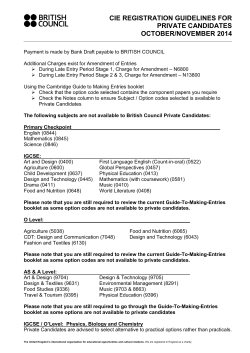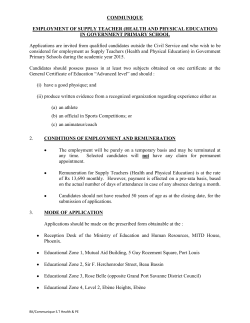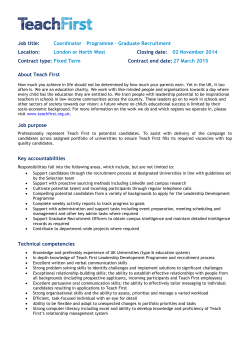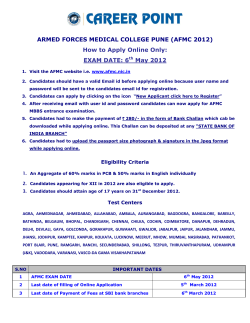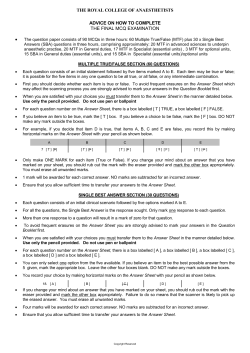
Centre Event December 17th
Centre Event December 17th Introductions • Rosie Radford Qualification Manager (case study) • Paul MacGregor Qualification Leader (multiple choice) • Anne Sleath Qualification Group Manager • Chief Examiners Tony (Haulage) Gilbert (Passenger) What we’ll cover 1. The qualification – what’s different? 2. How we’re listening and improving 3. Question types and how to approach them 4. Flexibility for candidates 5. Fairness for candidates 6. Communication The qualification What’s different? Open book – reflects real world • Want candidates to show they can SELECT and USE information APPLY – show understanding of that information • Time is limited, so they still have to ‘know their stuff’ Open book = no pre release • To prevent copying from model anwers • To test their ability to APPLY, like in the real world How does this affect the questions being asked? Unlike old CPC, there are very few marks for showing JUST ‘what you know’ “State FIVE items of equipment that must be carried on a vehicle when carrying dangerous goods.” (March 2010, Unit 4) How does this affect the questions being asked? In new CPC, may still be asked to ‘give’ or ‘state’, but these won’t just be items that can be easily found in texts “a) For the loading operatives, give FIVE actions to be taken BEFORE starting to load” (Sept 2012, R2) Remember: We’re unlikely to be looking for simple facts stated in standard notes or documents How we’re listening and improving Making the qualification clearer Why are we making it clearer? It’s fairer for candidates Because: • they know exactly what we want from them • it makes the marking of their scripts more consistent How are we making it clearer? Questions are more transparent about what will and won’t gain marks • “Without amending running time, minimum stand time or frequencies” • “Include in your answer any criteria which would have to be met to achieve this” Questions are explicit about • format: - “Draw a single combined chart” - “Show ALL your workings” - “Name each cost” • number: - “Give FIVE documents…” o Rewards competency o Avoids reward for “saturation bombing” And questions reward what matters: • They start with competency – what really matters? What would show you would be a safe TM in the real world? • For example: Organisation charts – no longer have a mark for a tidy/clear layout. Now have a mark for “all the staff that are required and no staff that aren’t” So… If we want a candidate to do something, we • tell them that we want them to… • tell them in how much detail • give them marks for doing it We also • tell them what gains marks • tell them how many marks they can gain Chief Examiner Reports Chief Examiner Reports: • still give common wrong answers • But now more emphasis on: • giving help and guidance • giving a guide to right answers/calculations/schedules • outlining how any issues raised by centres/candidates were addressed Question types and how to approach them Aim is to update you on: •the level of questions •the types of question we now ask •common mistakes by candidates in interpreting question types •tips and techniques for approaching types of questions The level of questions Level 3 Reg EC 1071/2009 states that the exam must be at Level 3: “The knowledge to be taken into consideration for the official recognition of professional competence by Member States…may not be below level 3” Level 3 OfQual (Independent Regulator) definition: Level Intellectual Skills and Attributes Processes 3 • Apply knowledge and skills in a range of complex activities, demonstrating comprehension of relevant theories • Access and evaluate information independently • Analyse information and make reasoned judgements • Employ a range of responses to well defined but often unfamiliar or unpredictable problems • Operate in a variety of familiar and unfamiliar contexts using a range technical or learning skills • Select from a considerable choice of procedures • Give presentations to an audience What does this mean for candidates? When reading the case study and the questions Candidates must be able to: •Evaluate the information in the case study •Analyse that information, and make judgements based on it •Use technical and educational skill to: • Manage unfamiliar and unpredictable information and questions When answering the questions Candidates must be able to: • Evaluate a question • Choose the appropriate way to respond to its demands • Respond in a range of different ways • Not just give facts but show they can apply the knowledge they have • Take part in ‘complex’ activities, so - reflect complex information from a scenario - give a comprehensive explanation - complete a complex schedule or calculation The Case Study Tips • Read it ALL carefully • Highlight things they might miss on a second read Remember • We are not trying to ‘catch candidates out’ • The information they need is in the case study • Remember to relate answers to the case study. If a question asks for implications for an Operator’s Licence, candidates must give the PARTICULAR implications for the company whose licence is discussed in the case study Question types and how to approach them Question types and how to approach them what we’ll cover: 1. ‘Numerical’ type questions - Scheduling - Costing/Budgeting/Calculations Question types and how to approach them what we’ll cover: 2. ‘Non numerical’ type questions: - Types: • ‘Give FIVE’ questions • Paired answer question • Organisation charts 3. Tips for all types • The verbs we use in questions • “What About Exactly Showing Your Answer”? • Time management • Clarity Scheduling Tips: •Remember to ‘convert’ times correctly - 120 mins = 2 hours, not 1hr 20 mins - 2.25 hrs = 2hrs 15 minutes, not 2 hrs 25 minutes •If a schedule becomes illegal, marking stops there - keep a ‘running total’ of accumulated hours down the side - can easily see when a driver has done, say, 4.5 hrs driving •Be clear about the activity – is it a break or a rest? •Is the schedule single or double manned? Scheduling Make sure to READ the case study carefully. Pay attention and stick to: •the company policies that may affect driving •the legislation which will affect driving Scheduling Make sure to READ the case study carefully. Pay attention and stick to: •the TIMINGS/DURATIONS given. Candidates may need to - work forwards from a departure time - work backwards from a ferry, arrival or activity completion time - bear in mind durations for breaks or unloading •When the schedule is from/til - The end of Monday? 24 hrs from the driver’s start time? - Don’t lose marks giving too short a schedule or waste time by giving one that is too long! Costing/Budgeting/Calculations Marks are available for workings/calculations. If these can’t be read then they can’t be marked. •Make calculations CLEAR. •Make sure they are laid out TIDILY and can be read easily. •Make sure each cost or item is NAMED. •Do each calculation separately and give an answer for each calculation. (This will also help if with going back and making corrections.) Costing/Budgeting/Calculations Tips: •It may help to highlight relevant columns or data in the case study before beginning •Check whether the question gives specific details about how much/how many: - Is the budget for a week? A day? A year? - Is the cost for a one way trip? A return? - Is the calculation for all the buses? The ones on service A? ‘Give FIVE…’ style questions In ‘Give FIVE…’ style questions, only FIVE answers will be marked. REMEMBER: • ALL questions with numbers in them are marked in this way • ANY number and verb can be used. So, you may see ‘Explain TWO…’, or ‘Describe NINE…’ ‘Give FIVE…’ style questions Why? • Tells candidates exactly what we expect from them to gain the available marks and how to use their time usefully. • Rewards candidates who know the right answers and who therefore show competency. • Prevents reward for “saturation bombing” and gaining marks from the small % which is right. • To do otherwise would disadvantage candidates who respond to the question as asked (and give five). Tips for approaching ‘Give FIVE’ questions • Lay out answers clearly • Make sure each answer is plainly separate • Only give the number of answers requested. Don’t waste time on things that won’t be marked. • If a candidate has more than X potential answers, they should start with the ones they are most sure of Paired answer questions Some questions ask that candidates give • a certain number (X) of items - AND FOR EACH ITEM • candidates must give, for example, an explanation or reason Paired answer questions REMEMBER: • The first X items are marked, along with the explanation/reason that accompanies each of THOSE first X. • If an explanation/reason isn’t given for any of those first X answers, candidates lose the opportunity to gain those marks. Paired answer questions – an example Give TWO personal documents the driver must carry and for each explain why (4 marks) The prescription for his painkillers (1) A letter of authority (1) A letter of Attestation showing why the driver has missing driver’s hours records A letter of authority proving the driver has permission from the owner to drive and use the vehicle Paired answer questions - marking All four of the DOCUMENTS listed AND the explanations given are correct. BUT: • he was asked to give TWO, and FOR EACH give an explanation. • so only the first TWO items are marked, along with their explanation. • as he gives no explanation for one/both of his first TWO, he has lost the opportunity to gain those marks. This candidate above can only get two out of the four available marks. Tips for approaching ‘Paired answer’ questions • Lay out answers clearly • Place each answer with its relevant explanation/reasons and make each of these sets separate • Only give the number of items and explanations/reasons requested. Don’t waste time giving answers that won’t be marked Tips for approaching ‘Paired answer’ questions • If candidates have more than X potential answers, - use the items for which they have (the most) explanation(s)/reason(s) THEN - use the items where they have no explanation/reason but feel confident of the item Organisation Charts REMEMBER •include EVERYONE who they have been asked to include •do not include ANYONE who they have not been asked to include •use the role titles given in the case study •staff of ‘equal rank’ should be at the same ‘height’ on the chart •staff who have a manager/superior should be joined with a vertical line Organisation Charts DRAW CLEARLY! If a chart cannot be interpreted then it will not get full marks •Lines should be horizontal and vertical. There is rarely a need for diagonal lines •Lines should be drawn straight •Place staff in boxes, so they are easy to read •Do not use colours Organisation Charts – an example Depot General Manager Depot Accountant Depot Transport Manager Depot Workshop Manager Transport Supervisors Mechanics Drivers Yard Man The verbs we use • The verbs used in questions (the ‘command words’) tell candidates what is required of them • Remember: to get marks, candidates MUST answer the question that’s been asked! • Failing to follow the command word is probably the single biggest cause of candidates scoring poorly • There are three ‘levels’ of depth required. The verbs used fall into three categories: 1 Verbs like give/state 2 Verbs like describe/outline/detail 3 Verbs like explain/analyse Verbs like give/state • The least demanding of the command words • Do not require an explanation, or a very detailed description • Require the candidate to select the right information/knowledge and demonstrate it straightforwardly • Might also be phrased, ‘What documents…’ or, ‘What items…’ Tips May need more than a couple of words to make the item specific For example, “Give four documents that must always be carried on the vehicle outside the UK” X a community licence isn’t specific enough, because what actually must be carried is √ a certified copy of the community licence For example, “Give three pieces of information on the driver daily vehicle check sheet” X date √ date of vehicle inspection or isn’t specific enough for a check sheet, but date of fault rectification is Tips Caution! Check what comes after the give/state Don't let verbs like ‘Give’ or ‘State’ hide what the rest of the question asks for: For example, “Give five actions…” X restraints is not action: even suitable restraints is not action √ check restraints are suitable for the load IS an action! Identify • “Identify” used to signify that we wanted the simplest items of information • With open book, marks are rarely given for very simple items that can come straight out of a book • Now when we use “identify”, we tend to mean “engage in a thought process and give us the result of that” Identify For example: “Identify where the plan does not meet the requirements of the legislation” X The answer to this is not just 1st √ week but The inspection period between the first week of January and the 3rd week of January is too long Verbs like describe/outline/detail Describe/outline/detail: • These verbs ask candidates to do more than just give an answer • Definition: “To characterize, to give the main features or various aspects of, to summarize” • We expect them to give details, or a description. • A few words, or a list, will not be enough • Candidates should ask themselves ‘HOW?’ and make sure that those details are covered in their answer For example, “Describe ten defects which would render the tyres illegal” X Cuts is not a description. Neither is Wear. (Think: HOW? (would they render them illegal)) √ Cuts in the tyre in excess of 25mm or Wear deep enough to expose the ply or cord both give a description – they have detail Verbs like explain/analyse Explain •Most challenging kind of question; it asks for depth and reasoning and judgement •Explain: “To define, to offer reasons for or a cause of, to justify” •Not just describing; needs to - go into thorough detail AND, where relevant - think about reasons (ask, ‘why?’) For example, “Explain how nine additional or higher costs could arise as a result of carrying out international journeys” X Tolls • does not EXPLAIN how a higher cost arises • does not give details √ Tolls can create higher costs (WHY?) BECAUSE many motorways in Europe charge tolls, unlike in the UK where there is only one toll motorway • has DETAIL AND REASONS For example, “For the criteria of financial standing, explain what OCR will need to demonstrate to the Traffic Commissioner” X £7700/£4200 • does not EXPLAIN • does not go into detail OCR will need to show that they have (details) £7700 for the first vehicle and £4200 for every other vehicle (WHY?) because they have to demonstrate that they have enough money to keep the vehicles in a fit and serviceable condition √ • has DETAIL AND REASONS Not all ‘Explains’ require reasons BUT they must still go into detail AND answer the question. If a question asks for a process or steps, that is what is required for the marks. For example, “Explain the process which would enable each subsidiary company to obtain its own Operator Licence” X GV79, TM1, ad • does not give DETAIL AND • does not explain the PROCESS Each subsidiary company needs to complete a GV79 form and submit it to VOSA 9 weeks before the licence is required. They must place an advertisement in a local paper 21 days… (etc) √ • Gives DETAILS AND • Explains the PROCESS Tips • Candidates should ask themselves “WHY?” and make sure the ‘‘BECAUSE” is covered • Check what it is they are supposed to be explaining – a reason? A process? Make sure to answer the question! • Write in full sentences • Go into thorough details The verbs we use … and what comes after them DON’T FORGET to look at what comes after the verb: •State which •Calculate whether or not •Explain how •Explain why This is part of the question. If candidates miss this, they may be answering the wrong question, and losing opportunities to gain marks! Examples Give four items the driver must carry and for each explain why • Asks: WHY does he have to carry them? • Not: describe the documents Explain whether the driver can operate this schedule for a complete week and give reasons • Asks: WHETHER = can he or can’t he? • Must say whether he can or can’t AND WHY! Examples Explain how nine additional or higher costs could arise as a result of carrying out international journeys • Asks: HOW would these costs arise? • Not: just ‘what are these costs?’ “What? About? Exactly? Showing? Answer?” Candidates often give good answers, but NOT to the question being asked! Ask: HAVE I ANSWERED THE QUESTION I AM BEING ASKED? BEFORE they begin an answer, there are five things they should look for: • What? • About? • Exactly? • Showing? • ANSWER! What? This is what the question is asking for. It is where the eye goes first. It’s the ‘meat’ of the question. Ask: WHAT do they want from me? For example: •A schedule •Documents •Defects •A tender Make sure the given answer is what is asked for! For example: if asked for tyre DEFECTS, don’t give examples of what makes a tyre LEGAL About? This is what the question is about. Ask: I know what I have to give, but what ABOUT? I have to give a schedule… about what? • The private hire for the Reading voice Choir I have to give a tender… about what? • School contract A34 I have to give required documents… about what? • The operation to the Italian lakes About? This information can usually be found: • Immediately around the ‘what?’ • In the stem or start of sentence A schedule for the wrong route/a costing for the wrong contract = no marks! Exactly? This is the specifics of the question, the details about exactly what is required. Ask: EXACTLY what am I being asked to give? Are there any specifics? How long/much/when exactly? • For the return journey • The daily cost • Up until the departure from Milan Exactly? What exactly? • Items other than vehicle parts and components • Personal documents Who exactly? • The drivers engaged on this service • The loading operatives Showing? This is what candidates are supposed to SHOW in their answer and how they are supposed to SHOW (present) their answer. Ask: what am I being asked to SHOW? Explicitly: • Show all your workings • Name each cost • In local time/in UTC/Add an hour • Standing/running costs separately • In GBP • A single combined chart • Give FIVE Implicitly ‘And/For each’: • Give reasons for your answer • Showing lines of communication • Include any criteria that need to be met • For each, explain why • And what provisions apply to these journeys • Include any criteria you’d need to meet Answer? This is the most crucial. It is the question they are being asked to answer. Ask: What question am I being asked to ANSWER? Am I being asked to: • EXPLAIN? Am I about to just state? • DESCRIBE? Am I about to just give a list? The VERB is what’s key (see ‘The verbs we use’) • Doing this last may help candidates have the most important thing in mind as they put pen to paper • This is also an opportunity to take a step back and ask again HAVE I ANSWERED THE QUESTION BEING ASKED? How about exactly showing answer? An example • “Consider the optional extras for the new vehicle to be purchased for RBAS Schedule 1. For each of any SIX items on the list, outline TWO benefits for the driver or the company.” • What? BENEFITS • About? Optional extras on Sched 1 vehicle • Exactly? For the driver or the company • Showing? TWO benefits for any SIX I choose • ANSWER? Give an OUTLINE! Time Management • How much time for each task? For example: - 15 minutes to read the case study gives - 105 minutes to answer the questions - 105/60 questions = 1.75 minutes per question. SO: • Allot around 21 minutes to a 12 mark question • Allot around 12 minutes to a 7 mark question Time Management • Don’t spend so much time on one question that they can’t answer another well or at all • Scan the questions before reading the case study, so they have an idea what they are looking for • Start with the questions they feel most confident about • Make sure they are ANSWERING the question asked Clarity The simplest tip of all is, BE CLEAR If an examiner can’t read an answer, they might not be able to see where it deserves marks •Write tidily •Separate each answer •Use good English •Write in sentences •Show all workings •Set out any calculations clearly and separately Marking – What you’ll see and what it means • • • • Margin marks - ticks, crosses and ‘I’s Circling and underlining “First five only” Paired answers Ticks/crosses/‘I’s and circling/underlining In long calculations/schedules, not every calculation/line has an available mark. Ticks/crosses are there to help revision. They show what is correct/incorrect even when marks aren’t available. Ticks/crosses/‘I’s and circling/underlining Symbol I Means circled/underlined part is: Correct Gains an available mark √ Correct No mark available for this calculation/line X Incorrect Whether or not a mark is available First X only and paired answers If a question specifies a certain number of items or explanations, only that many are marked. So, you may see a line and ‘first X only’: “Give TWO documents the driver must carry” (2 marks) The prescription for his painkillers A letter of authority A letter of Attestation (1) (1) first 2 only Flexibility for candidates Flexibility for candidates • Candidates are in difficult conditions: - under examination - under time pressure • We understand this and are flexible with regard to the answers they give • We do this via: - Mark schemes - Standardisation Mark Schemes When? •Written when the paper is written How? •More correct answers listed than marks available •Give flexibility for assessors to reward different ways of saying things •Give alternative answer formats Alternative answer formats For calculations •Reward different methods of arriving at the right answer • Leap years/52 weeks/365 days For scheduling •“Accept any legal division of driving/other duties” For other questions •“Loads have not moved OR restraints have not become loose” •“International drivers command higher wages OR subsistence allowances are higher OR antisocial hours” Standardisation When? •Once marking has started How? •Examiners add answers to mark scheme - Allows other ways of saying things: •“The candidate who simply states that OCR will need to apply for a new “O” licence to cover the Fishguard depot is by implication saying that their current licence does not cover it” - Allows other ways of calculating/scheduling - Rewards creativity – new answers are added •“cost of using checking facilities at ports” •“aerodynamic kits improve company image” Standardisation • Allows examiners to be responsive to any issues candidates might be encountering/raised by centres - “Drivers’ wages” = • There are two drivers and each costs… • Total cost for both drivers is… Alternative calculations were given and both interpretations could gain full marks. Fairness for candidates Fairness for Candidates • It is very important that all candidates are treated fairly. • A candidate who takes an exam in one session should have to meet the same standards in order to pass as a candidate in another session. • We achieve this through ‘Awarding’. Awarding When? • Once all scripts have been marked Who? • Group of industry representatives who have marked all the scripts Aim? • To set a fair pass mark A paper that is: Will have a pass mark that is: As hard as expected 30/60 Harder than expected Lower For example, 28/60 Easier than expected Higher For example 32/60 • Having to achieve a higher score on an easy paper is the same as having to achieve a lower score on a harder paper • Means centres always know the standard that is expected for candidates to pass • Means that candidates have to meet the same standard each session • Ensures fairness for all candidates Awarding How? • Look at a range of scores (scripts) • Identify competent candidates • Identify what mark competent candidates are getting • Consider last year’s competent candidates • Set the pass mark % passing is only considered afterwards Post Assessment Services – Why? To promote fairness by allowing centres to: • see how a candidate's script was marked • request a review of that marking Post Assessment Services – What? ‘Access To Scripts’ (ATS) • see a candidate’s marked script (and/or) ‘Enquiries About Results’ (EAR) • have the marking of a script reviewed Different EAR levels: • (I) Marking is clerically checked • (II) Marking is reviewed by another examiner, without a report • (III) Marking is reviewed by another examiner, with a report (also available for a group) Post Assessment Services – What? Reviewing examiners are • not trying to ‘find marks’ or upgrade a candidate • not trying to ‘preserve’ the original result The second examiner marks the script again to give a second opinion. Post Assessment Services – Tips Tips: • Use the ATS service first. This may save you/your candidate time and money • Use I or II if a candidate is near to the pass mark and wishes to have their script reviewed in case it changes their result • Use III if a candidate wishes to have feedback to assist them with revision/passing a resit Post Assessment Services – How? How? ATS and EARs MUST be requested: • by the centre (NOT by the candidate) • directly from the ATS/EAR team (NOT via the QM) On the website, go to: • ‘OCR for…’ • ‘Exams Officers’ • Choose the ‘Vocational’ tab Communication Contacts To save yourself time, please go to the right team for your query! For any query or if you’re not sure specifically who to contact: Email: vocational.qualifications@ocr.org.uk Tel: 02476 851509 Fax: 02476 421944 These advisors can direct you to exactly the right person Contacts For administrative advice and support and help with Interchange and e testing : cast@ocr.org.uk For entries, certificates and other operational queries: keyskillsopsteam@ocr.org.uk For centre approvals and inspections: OCRQAPT@ocr.org.uk For ATS and EAR queries: VQResult.Enquiries@ocr.org.uk Contacts Queries about the contents of a question paper should be directed to Paul MacGregor and Rosie Radford who can both be contacted at examined@ocr.org.uk
© Copyright 2025

